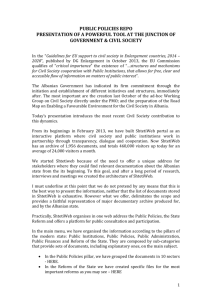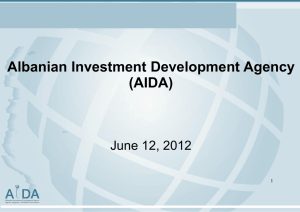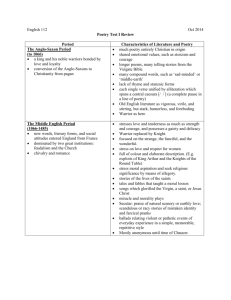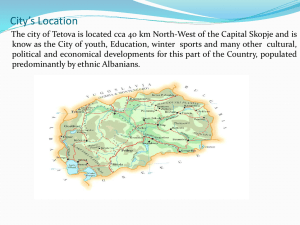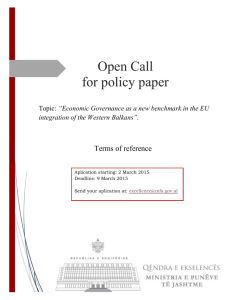alb
advertisement
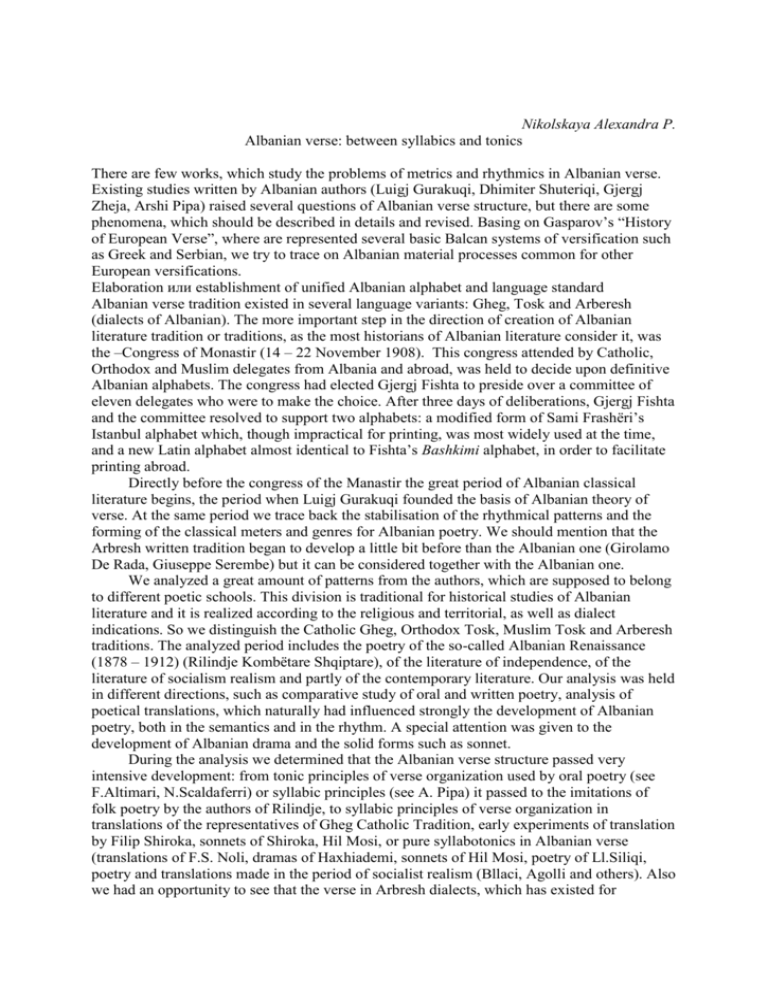
Nikolskaya Alexandra P. Albanian verse: between syllabics and tonics There are few works, which study the problems of metrics and rhythmics in Albanian verse. Existing studies written by Albanian authors (Luigj Gurakuqi, Dhimiter Shuteriqi, Gjergj Zheja, Arshi Pipa) raised several questions of Albanian verse structure, but there are some phenomena, which should be described in details and revised. Basing on Gasparov’s “History of European Verse”, where are represented several basic Balcan systems of versification such as Greek and Serbian, we try to trace on Albanian material processes common for other European versifications. Elaboration или establishment of unified Albanian alphabet and language standard Albanian verse tradition existed in several language variants: Gheg, Tosk and Arberesh (dialects of Albanian). The more important step in the direction of creation of Albanian literature tradition or traditions, as the most historians of Albanian literature consider it, was the –Congress of Monastir (14 – 22 November 1908). This congress attended by Catholic, Orthodox and Muslim delegates from Albania and abroad, was held to decide upon definitive Albanian alphabets. The congress had elected Gjergj Fishta to preside over a committee of eleven delegates who were to make the choice. After three days of deliberations, Gjergj Fishta and the committee resolved to support two alphabets: a modified form of Sami Frashëri’s Istanbul alphabet which, though impractical for printing, was most widely used at the time, and a new Latin alphabet almost identical to Fishta’s Bashkimi alphabet, in order to facilitate printing abroad. Directly before the congress of the Manastir the great period of Albanian classical literature begins, the period when Luigj Gurakuqi founded the basis of Albanian theory of verse. At the same period we trace back the stabilisation of the rhythmical patterns and the forming of the classical meters and genres for Albanian poetry. We should mention that the Arbresh written tradition began to develop a little bit before than the Albanian one (Girolamo De Rada, Giuseppe Serembe) but it can be considered together with the Albanian one. We analyzed a great amount of patterns from the authors, which are supposed to belong to different poetic schools. This division is traditional for historical studies of Albanian literature and it is realized according to the religious and territorial, as well as dialect indications. So we distinguish the Catholic Gheg, Orthodox Tosk, Muslim Tosk and Arberesh traditions. The analyzed period includes the poetry of the so-called Albanian Renaissance (1878 – 1912) (Rilindje Kombëtare Shqiptare), of the literature of independence, of the literature of socialism realism and partly of the contemporary literature. Our analysis was held in different directions, such as comparative study of oral and written poetry, analysis of poetical translations, which naturally had influenced strongly the development of Albanian poetry, both in the semantics and in the rhythm. A special attention was given to the development of Albanian drama and the solid forms such as sonnet. During the analysis we determined that the Albanian verse structure passed very intensive development: from tonic principles of verse organization used by oral poetry (see F.Altimari, N.Scaldaferri) or syllabic principles (see A. Pipa) it passed to the imitations of folk poetry by the authors of Rilindje, to syllabic principles of verse organization in translations of the representatives of Gheg Catholic Tradition, early experiments of translation by Filip Shiroka, sonnets of Shiroka, Hil Mosi, or pure syllabotonics in Albanian verse (translations of F.S. Noli, dramas of Haxhiademi, sonnets of Hil Mosi, poetry of Ll.Siliqi, poetry and translations made in the period of socialist realism (Bllaci, Agolli and others). Also we had an opportunity to see that the verse in Arbresh dialects, which has existed for centuries in the syllabic surroundings, adapted the syllabic principles but contains very specific elements. We are fortunate with our material, because we collected some examples of Albanian folk poetry existing in syllabotonic surroundings, namely, the poetry of Petr Merzhev. In this paper we will try only to outline the sphere of problems and phenomena, which we have to explain. We should mention here without immersion in deep theoretical problems of contemporary theory of verse, that we have been obliged to use different methods of analysis because of unstable structure of Albanian verse. So we used the well-known system of construction of stress profiles, taking into account that the quantity of syllables in line is not constant in more than 75% of texts. So we examined separately clauses and beginnings of the line, presence and place of caesura. Also we carried out the classification of levels of accentuation proposed by V.M.Zhirmunsky on Albanian material, appointing a kind of regulars in reading of the reduced ë (specific Albanian sound, that is not unlike the French sound e, which is known for its irregular reading). Naturally we agree with the opinion of such scholars as V. Kholshevnikov, V. Zhirmunsky, L. Timofeev and others, that the difference between rhythmical intonational systems of the languages raises the differences and nuances of the systems of versification. So we had to definite firstly the main characteristics of Albanian prosody in connection with verse. 1. Stress in Albanian Language Kolec Topalli defines it as dynamic, constant in the paradigm, and striving for the penultimate syllable. But in the process of speech we have more difficult picture firstly because of existence of definite and indefinite forms of the nouns (fushë – fusha, qytet – qyteti), also because with the addition on different grammatical indices the place of the stress could be found even on the third syllable (fushë > fusha > fushave; punoj > punova > punuakam), secondly, there are a lot of short worlds in Albanian which don’t carry the stress themselves, such as auxiliary verbs, pronouns, articles etc. Besides that there exists the reduced sound e, which could be pronounced or not depending on the dialect, preferences of the speaker, and in the verse conditions depending on the rhythmical or metrical structure. So all this peculiarities create the picture rather various and productive for the use of both syllabic and tonic principles. 2. Different interpretations of the stressing in the word and other difficulties of the recitation. One of the most difficult obstacles in the study of the rhythm of both foreign and native poetry is the absence of the clear rules of accentuation. As a result of this problem there appears an other one: it is known that binary system of arrangement of the stresses does not show us the real picture of rhythm. In Albanian tradition we have it very obvious, because of relatively short history of written poetry. So we had to answer several questions, which we consider very important in the study of the system of versification. 1. Is it possible to change the position of stress in the word if it requires the meter? The answer seemed to be negative, but we found a lot of examples of the stress transmission in the auto semantic words in Arbresh poetry, which disprove this thesis. Also we found some examples of this phenomenon in pronouns, auxiliary verbs and other syntactic words in Albanian poetry. 2. Are there the worlds fully, partly or never stressed? Yes, there are several categories of such words. For example, we define some monosyllabic words which can be divided in 3 groups: always stressed (nouns which have special meaning or verbs (on metrically weak position - s'di ç'nomatisa me gishtrinj (Petriti) metrically strong position - As unë s'di nga vete dhe nga vij (Asdreni). 3. When should we read the reduced ë? As we already mentioned there is no unified rule of the pronunciation of the ë. So we tried to find those regulars and came to the conclusions that: a) The authors of the National Albanian Renaissance, understanding that the relationship between the author and the reader is provided by the written text and being influenced also by the European literature traditions (Italian, French, German etc.) used to note cases when the ë shouldn’t be pronounced by he sign of hyphen or apostrophe or they didn’t used it in such cases. But here we meet some difficulties because when we have to work with editions of the beginning of the century we see those authors’ marks, but for several texts only editions of the later period (all XX century) are available In such editions we trace a lot of unnecessary redactor’s corrections, which destruct the rhythm and even the meaning. b) In the texts, which we call the texts with syllabic tendencies (especially sonnets of Gheg poets) we see that the reduced ë should be pronounced in most cases. We explain it by the requirements of the pseudo syllabic meter (the authors were trying to regulate the length of the line by pronouncing the ë not only in places where it could appear but also by adding it where it is not foreseen by the rules of the language). c) In texts with syllabotonic tendencies of the beginning of the XX century that ë serves for regulation of the length of the line (as in syllabic verses) but also to regulate the order of the strong and weak places of the verse (stressed and unstressed syllables). This mode of using the ë played rather important role until the 40’, when partly under the influence of Russian poetry, partly with the hole process of stabilization of the literary language, the language of the poetry is approaching to the spoken one and as the result the pronunciation of the ë began to be realized seldom and even the reader feels it like a poetical weakness. Just few examples: a) Falling of ë before the vowel: Këndo me rrall' e dal nga dal – Sing for me rare and slowly (Asdreni) or O gjuhë-e shentëruar, or mall me shpirtin plot – O what a saint language, o the soul full of sadness (Poradeci) Falling of ë before the consonant: vashë, që her’ më mbush ti ngazëllim // e her' trishtim e mall më derdh në gji? - My girl, that fills me sometimes with the happiness, but sometimes brings me sadness in my heart (Ll.Siliqi) b) Regulation of the length of the line by adding of ë Syllabic cases: më thertin shpirtin, zëmëren m'e vran It breaks my soul, it kills my heart (Serembe) Syllabotonic cases: Të rrosh a të mos rrosh - kjo është çështja // M'e lartë është vallë të durosh To be or not to be - that is the question:Whether 'tis nobler in the mind to suffer (Noli, translation of Hamlet) c) Using of ë in rhyme purposes: Ex. from J.Bllaci E ç'mund t'i them? Dëgjon të kthehet vallë Sërishmi zogu, që shtegtimin nis, Kur tjetër vis kërkon e s'e zë malli Per çerdhen, a per strehën që braktis? 4. How do we interpret the combinations of vowels ue, ye, ua, ie etc.? Those combinations of vowels are known in Albanian linguistics as true diphthongs (see A.V.Desnickaya), so both two parts of such diphthong must be equal and cannot form two different syllables. But in practice we find a lot of patterns where according to the requirements of the meter and rhythm they not only can be divided between two syllables but also one of the sounds can be reduced, they can change the place of the stress (and we will consider them as rising and falling diphthongs). There can occur also the case of monophthongisation or hiatus and so on. But we find no one true diphthong. 5. Is the elision used in Albanian poetry and in which conditions? The elision is strongly associated to the syllabic mode of the regulation of the rhythm. We met a lot of cases of elisions of Italian type in the dramas of Santori, sonnets of Serembe, Gheg Catholic poetry, translations of French (ex. from Baudlere, La Fontaine), Spanish (ex. sonnet of Servantes), Italian (Leopardi) texts. And like in the situation with ë, in the syllabotonic texts elision could be found rather often, but with the course of time its importance is loosing positions. 3. The relationship between oral tradition and written poetry. Here firstly we should mention the work of Arshi Pipa, which was “fogotten” and prohibited during the period of Albanian socialism. He was the first one who didn’t try to apply the existing theories on the Albanian material (for ex. like Gjergj Zheji, who used the syllabic scheme analyzing Albanian poetry on different dialects and variants of the leterature language). So in the work “The Albanian Verse – structure and genres” he distinguished the Gheg (northern variant) and the Tosk (the southern one) and call them accent syllabic for Gheg and icto syllabic for Tosk. As for Arbresh oral tradition we have an opinion of F.Altimari and N.Scaldaferri, who consider that the structure of the most texts is organized around four basic stresses (in Albanian theory of verse they call it octosyllabic in spite of the fact that the syllabic principle of equal quantity of syllables in the line doesn’t work). So what do we have in the written tradition? By the second quarter of the XX century the basic syllabotonic meters are formed and are appropriated the typical features for the written tradition we mentioned above. The Tosk tradition (both Orthodox and Muslim) turned to the syllabotonic verse in most consistent manner. Here we have the iambic pentameter of dramas written by Haxhiademi. Different variations of iambic tetra- and pentameters we find in the wonderful and numerous translations of Noli. We should mention that it was him who translated the most famous dramas of Shakespeare – Othello, Hamlet, Romeo and Juliet etc., also he transferred on Albanian the texts of Longfellow, Boulder, Hugo, Servants, Kipling, Ibsen, Omar Cheam and others). Comparing the translations of F.S.Noli and Hil Mosi (the Gheg author of the same period) we see that the Tosk language is more adapted for syllabotonic translations, it transfers regularly syllabics by syllabotonics. Having analyzed different examples from various authors we find out that the percentage of stressed and unstressed syllables in such kind of translation and generally in syllabotonic Albanian verse is very close to the Russian type, as mention Gasparov it makes 1 to 2. The Gheg translations were naturally oriented by the Italian tradition and were using all the methods of regulation of the length of the line they had created – the reduced sound ë, elision, reduction and adding of the sounds. So and the native variants of the Gheg poetry used to be more syllabic, but with rather regular division of stressed and unstressed syllables to be pure syllabics. We should mention that the so called folk octosyllabic is transferred in written poetry or as trochaic tetrameter or as irregular octosyllabic, which could be analysed as a rhythm constructed on for accents. The iambic tetrameter is considered as a borrowing. The shorter syllabotonic meters don’t exist independently, they occur only in combination with iambic tetra-, penta- or hexameter. The iambic hexameter is considered as a rhythm analogical to Alexandrine line (12 syllabical). So the most developed syllabotonic meters by the second part of the XX century are the iambic pentameter and trochaic tetrameter or pentameter.


